SCHNABEL AUSTRALIAN TOUR 1939 May 17 – August 16 – 27 Concerts – II/II
Artur SCHNABEL – AUSTRALIAN TOUR 1939 PART II: Concerts n° 12 –27 (June 20 – August 16)
ADELAIDE, SYDNEY, MELBOURNE, CANBERRA, PERTH
After his fifth and last recital in Sydney, and a very welcome one-week pause, Schnabel gave three concerts in Adelaide before going back to Sydney for an orchestral concert with Szell, and then to Melbourne for four recitals.
12- June 20 ADELAIDE Town Hall Program 4
BACH Toccata C Minor BWV 911 & D Major BWV 912 – SCHUBERT Moments Musicaux Op.94 D780
BEETHOVEN Sonata n°25 Op.79 – Sonata n°24 Op.78 – Sonata n°32 Op.111
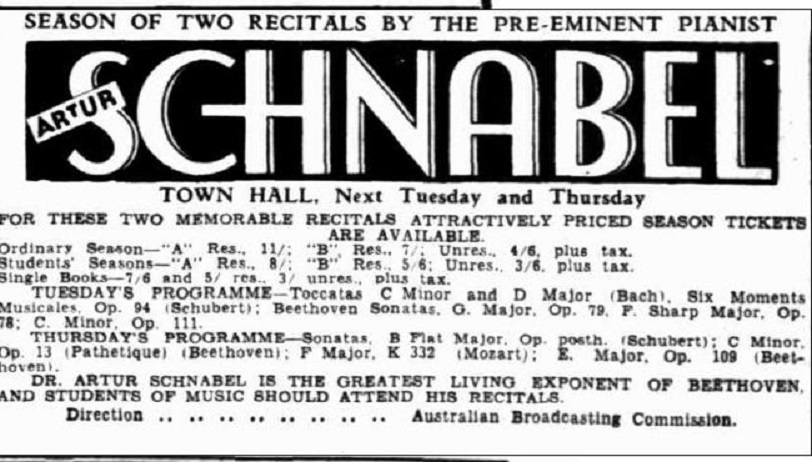
Advertiser (June 21): ‘To those so-called musical purists who are afraid to pedal Bach, Schnabel provides a useful lesson in his subtle and effective use of the damper pedal for coloring, sustaining as in sonorities, and obtaining a warm legatissimo which avoids that suggestion of brittle passage playing we sometimes hear in Bach. The opening number, Toccata in C Minor (Bach) was virile and meditative by turns. Its fugue flowed smoothly with no exaggeration of its subject matter, although every entry of subject or answer was announced with perfect clarity. With consummate discretion, this pianist reverses his use of rubato for those movements of Bach which do not call for rhythmical insistence. An outstanding example was the utter freedom of mood expressed in the « adagio » and recitative sections of the Bach D Major Toccata, his second offering. Its final movement, with its fascinating rhythmic qualities, showed the recitalist in happy humor. His masterly part-playing, and contrast of tonal qualities gives to his performance of Bach a wealth of musical significance. Schnabel, who loves to delve into the lesser known compositions of his favorIte composers, has discovered many hidden beauties in their style. The simple yet lovely Moments Musicaux Op.94 (Schubert) were given that tender poetic expression which they call for. Melodic phrases of ineffable charm, which might easily have been a little too square in treatment, were dwelt upon just long enough to be appreciated and absorbed by the listener and carried away as a rare memory. No facet of Schubert’s genius is missed by this understanding interpreter. Sonata in G Major. Op. 79 (Beethoven), with its gay opening movement, provided a somewhat lighter interlude to the programme. Schnabel, who never strains after effect, made no more of this slight work than there is in it. A dash of sentiment in the andante, and a facile performance of the final vivace, showed effortless technical ease. This unproblematic sonata, written in the condensed dimensions of a sonatina, was followed by Sonata in F Sharp Major, Op. 78, a two movement work which expresses only joy and gaiety. Very complete in the fullness of its expression, at times dazzling in its technical brilliance, this performance aroused spontaneous applause. It was in Beethoven’s great final sonata in C Minor. Op.111 that Schnabel rose to his greatest heights. His magnificent opening of the first movement, his titanic chords, scintillating scale passages, lovely tonal gradations and stupendous contrasts made the performance one of the greatest musical events in the history of this city. That Adelaide music lovers should have been privileged to hear the greatness of Schnabel in his prime is a thing which calls for an expression of gratitude. These reflections were prompted by his playing of the second movement, the spiritually exalted outpouring of Beethoven in his final offering in this form’.
13- June 22 ADELAIDE Town Hall Program 2
SCHUBERT Sonata n°21 B Flat D960 – BEETHOVEN Sonata n°8 in C minor Op.13
MOZART Sonata n°12 in F K.332 – BEETHOVEN Sonata n°30 in E Op.109
Advertiser (June 23): ‘In the in B flat. Op. posth. » (Schubert), making use of a « kunst pause, »‘ or what we might describe as an art pause, Dr. Schnabel isolated the opening theme of its first movement « molto moderato. » This was one of several such uses of pausation which gave the impression of breathing moments for artist and audience, allowing the completed phrase to be absorbed and musically digested before announcing the next. This movement, with its wide dynamic range, included the most subtle pianissimos, contrasted with fortissimos which had the compelling effect of clarion calls. Magnificent music, elevated with its nobility of expression, it provided an ideal opening number for the programme. « Andante sostenuto. », the second movement, with its exquisite poise, the Scherzo, ‘Allegro vivace con delicatezza’ with its innate grace and charm, and the final ‘Allegro ma non troppo » almost ingenuous in its thematic simplicity, were each interpreted with perfect understanding of their respective requirements. The lyrical beauty of Schubert and his restful quality of repose – leaving the listener beatifically unconscious of the passing of time – has surely, never found a more perfect exponent than Artur Schnabel. The opening movement of Beethoven’s « Sonata in C minor. Op. 13 » (Pathetique) ‘Grave-Molto allegro e con brio’ was fraught with an element of tragic plaint, rather than the pathetic questioning which it is so often made to express. Virility was its keynote, Unbroken rhythm was its burden. This impersonal, but powerful, quality was replaced in ‘Adagio cantabile’ by a mood which suggested a quiet intimacy of communion with one’s fellow being. The final ‘Allegro’ was brilliant and exhilarating. In the « Sonata in F major, K332 », Dr. Schnabel was the erudite, polished player, whose grip on essentials was always apparent. Perfect dynamic gradations, elegance of style, contrast of tonal values, crystalline clarity of passage work, particularly in the final « Allegro assai » were characteristics of a flawless performance. Above all else Mozart « lives, » in the hands of Schnabel, and a robust quality, which he uses where required, adds a note of strength to this stylistic genius. Schnabel hardly deviates a hairsbreadth from the printed copy, unless we except his rhythmic rubato. In the sudden transition from the initial « Vivace, ma non troppo' » to an unexpected « Adagio espressivo » in « Sonata in E, Op. 109 » (Beethoven), most pianists cannot avoid the temptation to become a little startling in their effect. Not so with Dr. Schnabel, who avoids such exhibitions of vulgar virtuosity as he would a pestilence. Again, proving his perfect accord with the spiritual message of Beethoven in his final period of maturity, Schnabel « held » his audience through this advanced work which makes no concession to what might be described as popular taste. It follows its own plan, untramelled by any other thought than the complete expression of its composer’s exalted mood. In a letter to Frau Streicher, Beethoven wrote: ‘Today is Sunday. Shall I read something for you from the Gospels? ‘Love ye one another’. It is this conception of serene happiness which we felt at the end of Schnabel’s performance of the Opus 109’. Brewster Jones
14- June 24 ADELAIDE Town Hall
Adelaide SO dir:Bernard HEINZE
MOZART Concerto n°27 B Flat Major K595
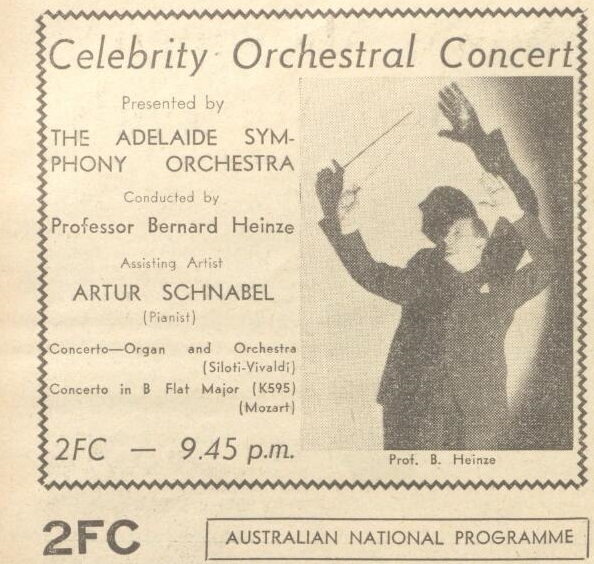
15- June 28 SYDNEY Town Hall
Sydney SO dir: Georg SZELL
BEETHOVEN Concerto n°5 Op.73
Sydney Morning Herald (June 29): ‘Through his lucid yet never rigid manner of playing, Schnabel opens to view the ultimate simplicity of the music. One had known beforehand, approximately the mode of attack he would bring to bear on the ‘Emperor’. Yet the actual revelation seemed perpetually surprising and refreshing. Schnabel can make even a repeated scale in octaves seem a musical adventure of redoubtable magnitude. Some of his playing last night was forceful and resplendent, some hauntingly delicate in its pale traceries of tone. But whatever he did, he did with no apparent physical effort. He seemed to be meditating aloud rather than building up a preconceived plan. The orchestral players provided many passages of beauty in the course of a generally well judged accompaniment. The opening melody of the slow movement for example was enchanting in its tenuous muted sweetness. The players, who were headed as usual by Mr. Lionel Lawson had not yet drawn together again into the full unity and coherence which Professor Szell had exacted toward the end of his previous visit. Schnabel’s utterly crystalline quality sets an exacting standard, and bv contrast some of the orchestral work last night tended to drag’.
Letter (from Sydney) to Mary Foreman (June 29): ‘My concerts, fifteen so far, meet striking response. Houses always crowded. Musical public life here is in its infancy… Music, as a value of its own, begins only to enter. They have not yet one permanent orchestra, but already five composed partly of amateurs, some founded only three years ago. The willingness is promising and astonishing are already the results. The state-controlled broadcasting, for which the subscribers pay, has the entire merit of this rapid developement’; and in another one, also from Sydney (July 3), he wrote: ‘Tonight, I start for my Melbourne recital session (as they call here appearances in each town), four recitals in one week; after my return on the 13th three more concerts here with the orchestra. It depends entirely on the developement in Europe where and when I go from here’.
16- July 5 MELBOURNE Town Hall Program 1
BEETHOVEN Sonata n°31 in A Flat Op.110
SCHUBERT 4 Impromptus Op.142 D935
MOZART Sonata n°8 in A Minor K310
BEETHOVEN Sonata n°21 in C Op.53
Age (July 6): ‘In the sonata op.110, Beethoven covered a great range of ideas. Schnabel is known as an intellectual. But if an artist is not instantly active in sensitiveness, there is little to put into his framework. The pianist fused his mental forces to give a comprehensive exposition of the sonata. Clarity goes along with Schnabel’s technique, and the cumulative effect, built up from the lambent first movement, and through the sharp and terse molto allegro, came to the utmost expressiveness, in the dolent arioso; while the fugue, as imaginative as ingenious, flood-lit the whole with seraphic illumination. The Waldstein sonata, ‘the C major of Life’, also received a lucid exposition. The enchantment was greater in this work, or more readily felt by some, its fabric being less involved, while its charm is throughout irresistible. The applause following the sonatas proved how greatly the music and the inimitable playing had impressed the listeners. Schnabel has taken Schubert to his heart, testifying to his joy in the miracles of ‘the most poetical of all the musicians’. As the artist cherished them while under his hands, the Four Impromptus, mirroring the soul of a pure spirit, brought the truly great Schubert to life. Mozart, akin to Schubert in the power to create imperishable music, was represented by the A minor sonata, of which a magically finished version of the quick movements was given. The Andante was less impressive’.
17- July 7 MELBOURNE Town Hall Program 5
SCHUBERT Sonata n°20 in A Major D959
WEBER Sonata n°2 A Flat Op.39
SCHUMANN Davidsbündlertänze Op.6
Age (July 8): ‘Dr. Artur Schnabel gave his second recital in the Town Hall last night to a large audience, in which most musicians of Melbourne were found. Schnabel’s control of the keyboard is sufficient for all need. The pianist appears to have no technique, so easy and relaxed is he in his movements. His free arms, supple wrists and fingers that intelligently weigh and measure, are such obedient servants that, impediments swept out of the way, the soul of the musician is free to express, with creative spontaneity, the content of the works he may have in hand. Technical equipment attracting no attention, the listener is the more able to concentrate on the music itself. Schnabel has made the world his debtor in bringing the marvellous beauties of Schubert to the fore. Pianists themselves must be blamed for the master’s neglect. The posthumous sonata in A is symphonic in wealth of ideas and richness, of fancy and feeling. The finely spirited performance, so extraordinarily instinct with vivacious thought, gladdened the heart and mind of every musical listener. Similarly revealing, though with different complexion and meaning, was the A flat sonata of Weber. The music had as much excitement, as the Schubert work, but less depth. All that it contained came out in the artist’s performance. It was Schnabel’s pleasure to treat every phase of the sonata with consummate skill. The characteristics and colors of Schumann’s Davidsbundler were very stimulating. Schnabel seemed to reflect completely the rapidly changing conceits and fleeting ideas of Schumann’s imagination. The highest effectiveness was given to the set, poetic Impulse and romantic energy ruling throughout. Schumann said of his Davidsbundler creation that it figured an intellectual brotherhood that he hoped would bear golden fruit. Of that brotherhood Schnabel is an ardent member, a fit exponent of romance at its best’.
The Herald (July 8): ‘Schnabel’s technique is never set in the forefront, but is completely at the service of his searching mind, and his mind is entirely pre-occupled with the musical thought of the works he is playing. The result is that his technique adapts itself to the style of the composer, instead of the style being twisted, as often happens, to suit the technique and temperament of the pianist. J. E. Tremearne
18- July 10 MELBOURNE Town Hall Program 3
BEETHOVEN Sonate n°3 in C Op.2 n°3
BEETHOVEN Sonate n° 17 in D minor Op.31 n°2
SCHUBERT 4 Impromptus Op.90 D899
SCHUBERT Sonate n°17 D Major Op.53 D850
Age (July 11): ‘Beethoven’s early Sonata in C offered opportunity for display, which the artist, while brilliant, kept within limits. The allegros were finely spontaneous and free; the adagio came as a resting time of tranquil pleading. The light-hearted rondo, with its staccato 6ths, rippled and danced to its coda without indulging in the boisterous humor of later Beethoven days. The dramatic D minor sonata, opening with sterner material, also found its reflective mood in the Adagio. Its eloquent meditation was not forgotten when the cantering lilt of the moto perpetuo brought the work to a close. Coming to Schubert, the Op.90 Impromptus revealed Schnabel’s sympathy with pure lyricism, which he expressed in precise, but exquisitely fluent, terms. The audience could not help but sing in spirit with Schubert’s engaging themes. The festive D major sonata has something of the impetuosity of the C major symphony. Its vigor and tunefulness are unceasing. Schnabel possessed the sprightly fancy to meet the ebullient imagination of Schubert, with the result that many marvelled that the master is so seldom heard, except for a few favorite Lieder. The captivating rondo, with its bewitching melodic grace, closed an evening of great music and uplifting experiences.
19- July 11 MELBOURNE Town Hall Program 2
SCHUBERT Sonata n°21 B Flat D960
BEETHOVEN Sonata n°8 in C minor Op.13
MOZART Sonata n°12 in F K.332
BEETHOVEN Sonata n°30 in E Op.109
Age (July 12): ‘Dr. Schnabel gave his final recital in the Town Hall last night. Very reluctant was the audience to part with an artist so universally esteemed. The master pianist has very human qualities. The B flat posthumous sonata of Schubert, copious in extent, rich in motives, and ever-quickening elation, made a majestic opening. Schubert never holds inspiration in reserve. All is frank and open. Whims, tears and an exuberant joyance flood his pages. Never is he feeble, nor redundant with all his repetitions. Schnabel saw that nothing of Schubert would be lost to the audience. It will be strange if the demand for more Schubert at our concerts is not forthcoming. Beethoven’s « Pathetic » sonata, every note of which is known to musicians, was played with serious and urgent emphasis, almost inking on the depth of a later opus, so impressively did Schnabel bring out its passion and the hopeful contentment of the rondo. The Mozart sonata is very direct in its statements, yet it is a pliable mind that captures the master’s best. Mozart is acquired intuitively. His spontaneity, grace and poise are to be possessed by the interpreter in a similar degree to that which the composer himself possessed them. Some have preferred Schnabel’s Beethoven to his Mozart and Schubert to his Beethoven. Others would draw no fine distinction. The audience listened with the closest attention to Beethoven’s Op.109, a leave-taking into which Schnabel put all his heart, and in which the audience felt all its gratitude. Here, perhaps, were the most momentous and imperishable impressions of Schnabel’s personality and art. From the semi-rhapsodic opening to the elaborate variations, all could catch a semblance of the Beethoven rapture. The brilliant coda declined in radiance when the initial touching theme returned to close a transcendent experience in tranquil repose. Ovations followed each of Schnabel’s performances throughout his historic season’.
In this very important letter to Mary Foreman (Sydney July 15), Schnabel wrote: ‘In all probability, I shall go back to Europe (if at all) via the USA instead of taking, as originally intended and booked, the Suez route. The danger of war remains acute, and to be (possibly) kept and caught somewhere in the Indian sea is rather risky, thus I decided to choose the comparatively safer way and to stay in case of the worst coming true in America. I shall leave on August 18th with the SS Monterey from Sydney, and arrive in Los Angeles September 4th’. In this letter, Schnabel also mentions the unexpected marriage of his second son, Stefan: ‘Stefan surprised us with his marriage, announcing it with a telegram to us, asking for the parents’ blessing, the message also signed with the first name of his wife (Joan). I have never seen the girl. Stefan has been wanting to marry for a long time, has known intimely several candidates whom after a while he dismissed all as not suited. I have to make the best of it and be confident and helpful as long as it goes’.
3 Extra Celebrity Concerts:
20- July 18 SYDNEY Town Hall
Sydney SO dir: Georg SZELL
BEETHOVEN Concerto n°3 Op.37
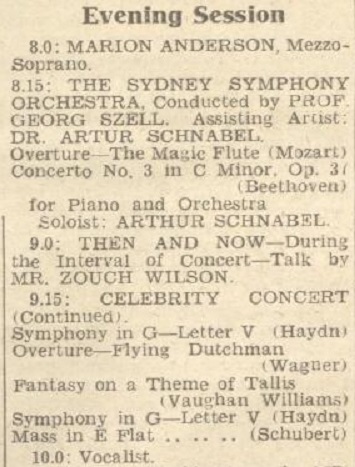
Wireless Weekly (July 26): ‘Artur Schnabel’s delicate and expressive rendering of Beethoven’s Third Concerto made the celebrity concert broadcast on Tuesday a memorable one. Simpler and more transparent than the ‘Emperor’, this work showed Schnabel in an entirely favorable light. The Sydney SO, conducted by Georg Szell, provided good support, though on occasions one suspected that Schnabel was applying the spurs. Schnabel completely transformed Beethoven’s C minor concerto by surrounding each change of mood with a delightful sense of intimacy. This seems to bring him closer to his audience than on any other occasion. The last movement – a particularly happy one – was played with more simplicity and restraint than is often heard. Throughout the work, every scale and arpeggio was treated melodically, in this way becoming more closely a part of the whole’.
During the tour, Therese Schnabel gave singing lessons to several pupils. The picture below was published in the July 20 issue of the Sydney Morning Herald:
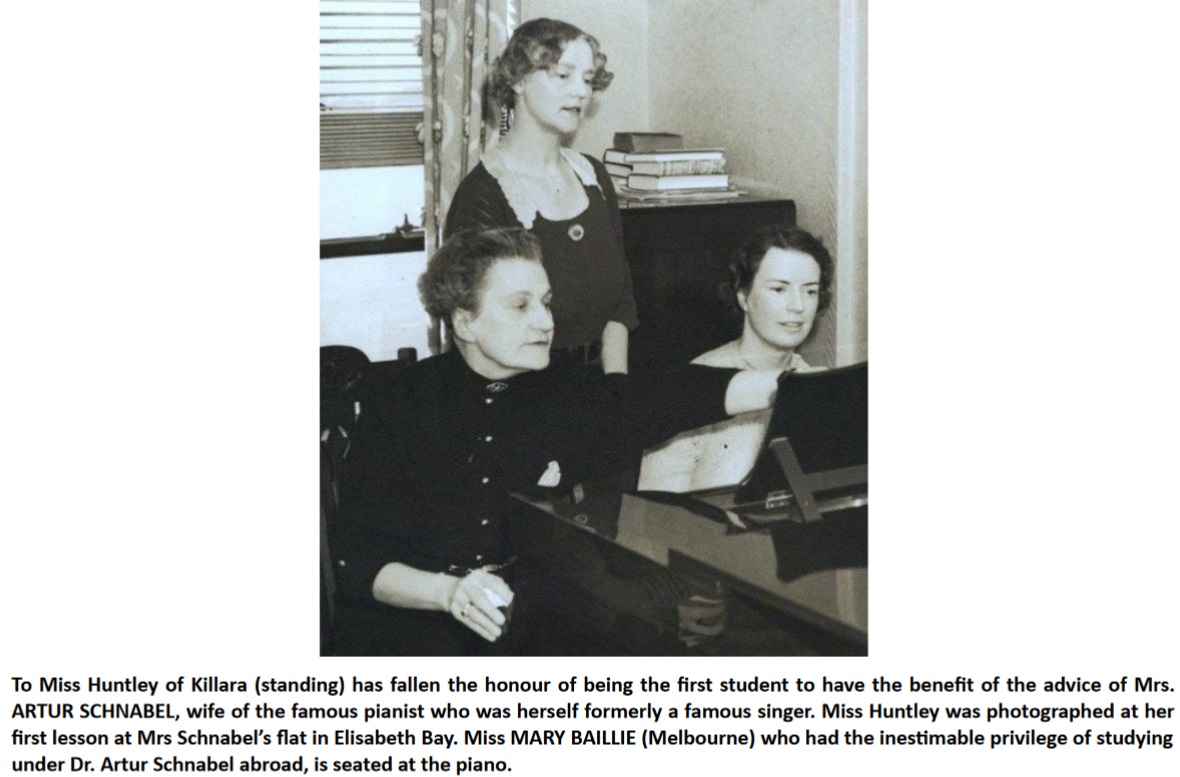
21- July 22 SYDNEY Town Hall
Sydney SO dir: Georg SZELL
BRAHMS Concerto n°1 Op.15
MOZART Concerto n°21 in C K467
WEBER Konzertstück

Sydney Morning Herald (July 24): ‘The complete change of pianistic character between each work and the following one illustrated once more Schnabel’s extraordinary command over style. The Brahms was in the grand manner, painted in with broad exuberant strokes. The Mozart exhaled gaiety, elegance and charm. The slow movement displayed in striking fashion the extreme significance which a highly sensitised intellect and emotional organisation can impart to material of the utmost simplicity. The Rondo was a triumph of nimble, incisive rhythm. The Konzertstuck was one of the most surprising performances that Schnabel has given during his Sydney season. Intrinsically, this music is sweet and spontaneous, but not deep. Like the earlier Verdi, it expresses emotion through lovely melody rather than through form and colour. The march theme which represents the knights returning from the Crusades is almost laughable in the naivety of its scene-painting. Yet Schnabel gave the whole thing such persuasiveness, such sparkllng beauty of ornament, such unspoiled directness and simplicity that it became a rich experience. The showers of decorative passages at the end proved once for all that Schnabel does not disdain a sheer sensuous mode of interpretatlon when it suits his purposes. His earnest approach to the classics is the result of intellectual conviction and not of any lack of temperament. The orchestra gave competent well-judged and sometimes engagingly delicate support to the soloist throughout the concert’.
In a letter to Mary Foreman (Sydney July 25), Schnabel wrote: ‘You will now know that I followed your advice to travel back via the USA, and this knowledge will mean a relief to you,… My work here has swollen to considerable dimensions: 27 appearances, 25 rehearsals, 35 big works, journeys, journalists, auditions, parties, correspondance. And no secretary with me. But, thank God, I don’t feel too tired’.
22- July 26 SYDNEY Town Hall
Sydney SO dir: Georg SZELL
BRAHMS Concerto n°2 Op.83


The Bulletin (August 2): ‘The swan-song of a notable musical partnership was sung at Sydney Town Hall on Wednesday night, with a performance of the Second Pianoforte Concerto of Brahms. The orchestra earlier in the evening had given a well-rounded, carefully rehearsed performance of Brahm’s Fourth Symphony, imparting to that work, usually considered so austere, many touches of tenderness and even geniality. The band came to the Concerto, therefore, in appropriate mood, and the result was a supremely satisfying reading of a remarkable work. The illuminative quality of Schnabel’s playing, particularly in declamatory or meditative passages, was never better exemplified’.
 Schnabel & Szell (Australia 1939)
Schnabel & Szell (Australia 1939)
23- July 27 CANBERRA Albert Hall Program 1
BEETHOVEN Sonata n°31 Op.110
SCHUBERT 4 Impromptus Op.142 D935
MOZART Sonate n°8 A Minor K310
BEETHOVEN Sonata n°21 Op.53

24- July 29 MELBOURNE Town Hall
Sydney Quartet: George White, Robert Miller,Vl William Krasnik vla, Cedric Ashton vlc
BRAHMS Quintet Op.34
MOZART Quartet K 478
DVORAK Quintet Op.81
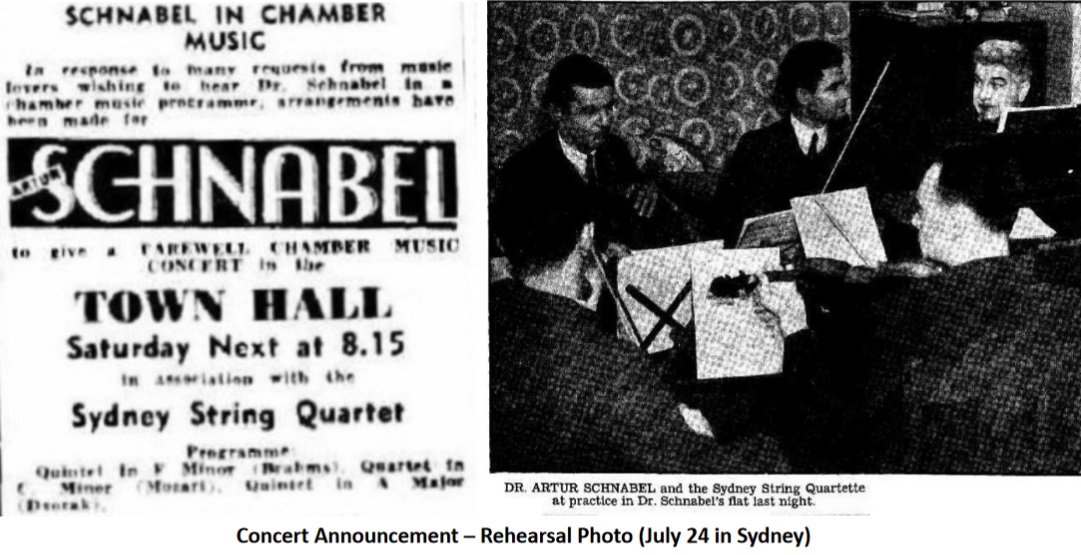
Age (July 31): ‘The concert given by Artur Schnabel and the Sydney String Quartet in the Town Hall on Saturday night was an event of first importance. George White, Robert Miller, William Krasnik and Cedric Ashton were the string players. Schnabel is a great solo pianist who enjoys taking his part in chamber music. The Sydney Quartet is a capable organisation that has given excellent recitals in Melbourne that are well remembered. Yet, it cannot be said that the ensemble was satisfactory. The strings appeared to lack confidence, but it was soon felt that the hall was too vast for chamber music. While nothing of Schnabel’s playing was lost, sensitive string tone vanished In the great spaces. Interest centered primarily in the works. The Brahms Quintet in F minor, occupied the performers with closely reasoned material. Contrast and variety sustained attention, and while the whole is uniform in excellence, the several movements hold distinctive features opening up new vistas for the intellect and the imagination. Mozart’s Piano Quartet in G minor, with its unclouded idealism, happy contentment and innocent gaiety, expressed with the usual economy of material made everyone good humored. The artists united to declare how inestimable are the treasures that have come from Mozart’s wonder-working brain. Of immense interest was Dvorak’s great Quintet in A. Its originality, wealth of melody, attractive modulation and independent writing bring it close to Schubert’s ideal. In this, the artists were at their best, both in playing and in effect. The vivacious and sympathetic interpretation quite caught the mood and meaning of the much-loved Bohemian master. The performers gained much applause for their recognition of the beauty in these great chamber music works’.
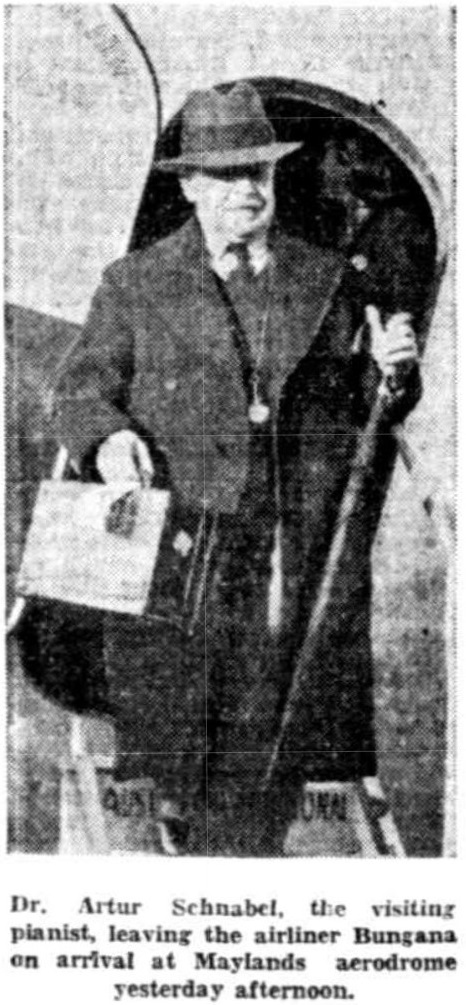
Schnabel’s arrival in Perth from Melbourne (August 6)
A Schnabel interview was published on August 7 in ‘West Australian’. To read it, click HERE
25- August 8 PERTH Capitol Theatre
Perth SO dir: Ernest J. Roberts
BEETHOVEN Concerto n°5 Op.73

In a letter to Mary Foreman (August 9), Schnabel wrote: ‘I had my 25th appearance. Perth is lovely. I am alone here. Perth is quiet, rather elegant, wonderful scenery, fascinating wild flowers, but life is tame. Culturally, comparatively a stepchild. Neglected. The orchestra (amateurs: bakers, shoemakers, street cleaners, etc.) not just a delight for the ear, yet amazing. Something noble and productive might grow even here, the entrance from Europe and Asia to Europe and America’.
West Australian (August 9): ‘We had the power and profundity of Beethoven through the medium of Artur Schnabel’s fingers last night. Making his first appearance in Western Australia, before a large audience in the Capitol Theatre, and under the auspices of the Australian Broadcasting Commission, Schnabel had chosen Beethoven’s Concerto in E flat, Op. 73. After Schnabel’s performance a pianist in the audience, hearing reference to details of the player’s pianism – his wonderfully even, crystalline trills were mentioned – retorted, « Yes, but I forgot all about that. » What was meant, was, more or less, what an English critic meant when he wrote: ‘Schnabel is not just an affair of piano-playing; he transcends the virtuoso’s vain job; he is the living medium of Beethoven’s spirit.’ One agrees heartily. The greater includes the less. Still, let us note that among the gifts which Schnabel places unreservedly and so self-effacingly at the service of the composer is a wide range of tone-power, a command of remarkably vital tone, and of very beautiful soft tones. There were many lovely smooth runs, with beautiful gradations. Perhaps the most beautiful experience the evening held was the opening of the concerto’s second movement, in profoundest peace, muted strings giving out a long, slow music of grave meditation; and then when it dies away, the wonderful effect of the piano’s entry, also meditative, but with another melody, floating down from high in the treble. The very significant orchestral part was managed, under Mr. E.J. Roberts’ direction, with praiseworthy care, and the coordination throughout the performance was good. ‘Fidelio’
26- August 12 PERTH Capitol Theatre Program 1
BEETHOVEN Sonata n°31 Op.110
SCHUBERT 4 Impromptus Op.142 D935
MOZART Sonate n°8 A Minor K310
BEETHOVEN Sonata n°21 Op.53
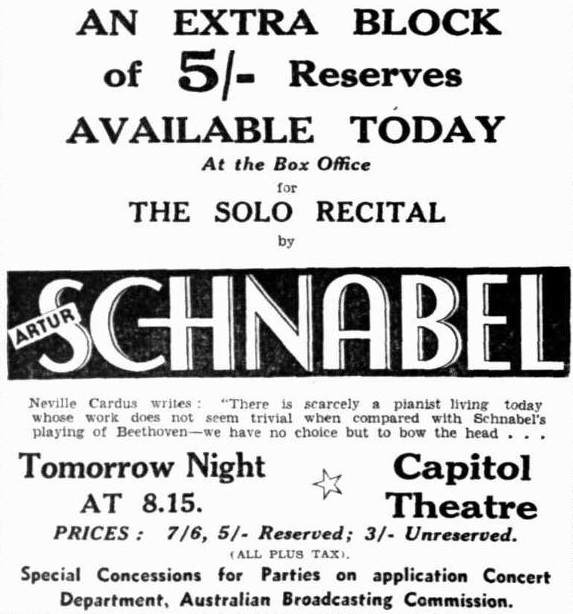
West Australian (August 14): ‘Wonders, as an acute thinker once remarked, will never cease. Here were we in our thousands, at any rate, as close as makes no difference to the maximum of 2,000 odd which is the capacity of the Capitol Theatre, listening to three piano sonatas (two Beethoven, one Mozart and neither the « Moonlight » nor the « Appassionata » included) and four longish Impromptus (Schubert) which amounted to a fourth. No artist visiting us has been so manifestly distressed by our extraordinary coughing habits as was Dr. Schnabel. His quick glance at us and pained shake of the head when bark broke in on Beethoven were frequent. This apart, it was an evening rich in profoundly impressive experiences. Particularly in Beethoven, the anticipations which the judgment of the musical world, together with our own foretaste in last Tuesday’s concerto had aroused in us were richly realised. To state the conviction which Schnabel’s playing drives, we are taken to the root of the matter. are in touch with, enveloped by, the Beethoven spirit, is to reiterate what has become a commonplace of Schnabel criticism but remains nevertheless the central fact. And, of course, it is more easily asserted than its rightness is demonstrated. There is, indeed, plain for every informed music-lover to see, the integrity of this playing, its fidelity to the text, excluding all ‘effect-making’ for which warrant cannot be found there. Take the first movement of the « Waldstein » sonata. Arrived, after the hurrying, on driving opening page or so at the contrasted, deliberate and expressive second subject, a pianist might be excused for making the most of the contrast with the help of a ritard, and quite a nice effect it would be (and, if memory is not playing one false, often is). But Beethoven has a different purpose, he has not directed any variation of the tempo; so Schnabel resists the temptation and drives the long movement on with unchecked impetus to the momentary slackenings marked by the composer just before its end. The onward driving force of this great piece of music, a purposefulness looking, so to speak, neither to left nor right, was an outstanding feature. Most impressive of all, however, was the profound beauty and significance of changing expression of the Adagio Molto movement, from its hushed opening, with the gentlest of pianissimos, to its passing into the final Rondo; and this passing out of shadows with the serene rondo theme’s first appearance, softly against flowing semiquavers and high in the treble, was a heart-catching, thrilling experience. Such magical moments with Schnabel are all the more potent in their effect because of the absence from his art of sensuousness, and its general masculinity and robustness. Some people, one reads, have not been able to accept the way in which this masculinity and robustness is applied by him to Mozart, who was represented in Saturday’s programme by a very fine sonata in A minor (K310), a work full of impassioned feeling and by no means music of « lavender and old lace » (to quote the sarcastic phrase with which the programme-annotator hit off a conventional view). From the lavender and-old-lace way of playing Mozart that of Schnabel is certainly separated by a considerable distance. How far in the Schnabel direction it is desirable to go may be granted to be a debatable point. Dogmatism on it would be rash, and it will not be attempted here. (One may add, though, that at least one of Schnabel’s passages in this sonata was given a tonal and textural exquisiteness which must have ravished even old-lace addicts). The recital opened with the last but one of Beethoven’s 32 sonatas, Op.110, in A flat, its performance adding one more to the collection of Schnabel records: it had not been played before in Perth, so far as we can recall, by any visiting celebrity. Beethoven was 51 when he composed it (in 1821) and had six more years to live. We must be grateful to Dr.Schnabel for letting us hear this noble and beautiful work, not less than for his masterly presentation of it. The strength and commanding asssurance in the final fugue were inspiring. Before the interval we had four Impromptus by Schubert (Op. 142). The First, in F minor, is virtually a sonata first-movement, a finely inspired piece, full of Schubertian warmth and vigour of imagination; the second is the well known Allegretto movement in A flat major, the third a beautiful series of variations on a theme from the « Rosamunde » music, and the fourth a lively, brilliant finale, somewhat in the Hungarian manner. Is it ungracious to mention the solitary qualification to one’s joyful appreciation of all this: the feeling of excess of repetitiveness by Schubert in the famous A flat piece, when all his repeat marks are observed, as they faithfully were by Dr. Schnabel?’ ‘Fidelio’

Schnabel’s meeting with Malcolm Sargent at Melbourne airport (August 14)
27-August 16 SYDNEY Conservatorium of Music
Sydney Quartet: George White, Robert Miller,Vl William Krasnik vla, Cedric Ashton vlc
MOZART Quartet K 478
DVORAK Quintet Op.81
BRAHMS Quintet Op.34

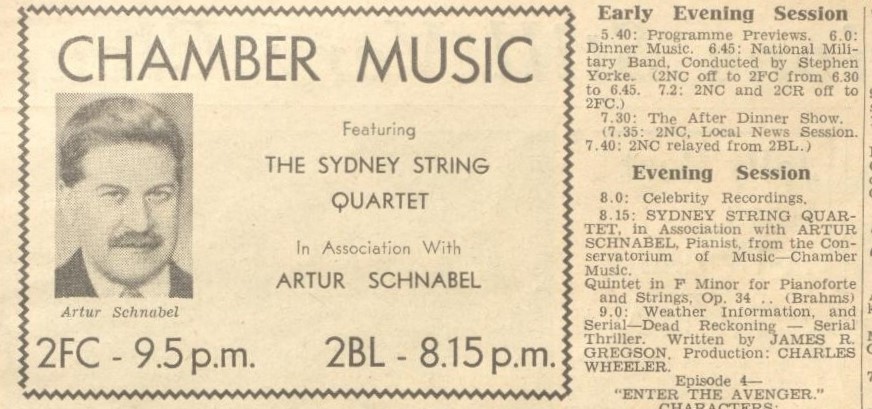
The Bulletin (August 23): ‘Quite the best of the many concerts and recitals in which Artur Schnabel has taken part in Sydney was the performance of pianoforte and strings at rhe ‘Con. Hall’ last Wednesday night which brought his Australian season to a close. The Sydney String Quartet collaborated with the Viennese musician in the Brahms F Minor Quintet , and the result was admirable. For once in a way the reserved and imperturbable Schnabel seemed to glory in the music, and the other instrumentalists played as they have never played before. Mozart’s G Minor Quartet (K478), which ranks with the symphonies in merit, was given the sort of performance its elegance and suave beauty demand. Schnabel is the ideal Mozart-player (he can make even a simple Alberti bass sound distinctive), and his manner, as in the Brahms, infected his associates, so that each voice had its say in exactly the right accents. Dvorak’s sensuously melodic Quintet in A (Op.81) brought a notable evening to a close. The attendance, though it crowded the ‘Con. Hall’, whose normal seating arrangements were extended, was not nearly of Town Hall dimensions, but it was quite obviously an intensely musical audience, and its sympathy and appreciation had their effect upon the performers.
On August 18, Schnabel left Australia with the SS Monterey from Sydney to Los Angeles. This was reported in the ‘Daily Telegraph’ the next day.
From his biographer, César Saerchinger, we know what this meant: ‘They had lost their German home, then their Austrian nationality; they were now forced to abandon their second home in Italy – for an indefinite time. And willy-nilly, they were now in their future adopted country, the United States. The war not only meant banisment fom one continent to another, but also a radical change in a long-established pattern of life. Schnabel was born an Austrian, had lived and thought as a German and a European in the fullest sense of the word…. Now, for the first time, he was obliged to remain stationary in the New World, and this at a time when his personal honeymoon with America was over, after the first impact of its conquest had been spent. ‘We are marooned’, he wrote to Walter Turner from New York. ‘Grateful as I am to be here, I am not happy… I feel great apprehension for the U.S.A., which in a sense I seem to love more and appreciate more highly than the majority of the people who «keep smiling»’. The basis of his apprehension was the deterioration of society under the pressure of materialism, and its exploitation as an ever-expanding market for mass-producted articles: ‘For music, there is no understanding of the prerequisites of its appreciation. Its mystical origin and its transcendental essence is not admitted… Obviously, there is no place for me here’.
From then on, he lived in the United States, until he was to see Europe again, but for this he had to wait until in May 1946. There, he resumed his musical activity with a series of concerts and recordings in London.



